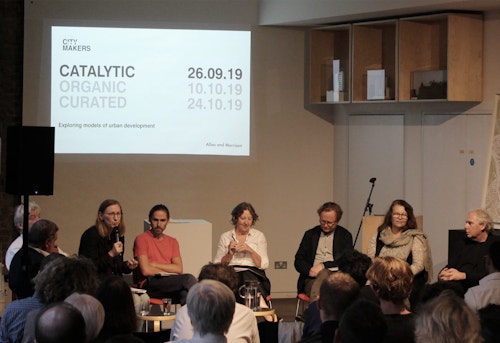/ Citymakers: Catalytic
What are the primary catalysts driving urban development?
by Paul AppletonThe first evening of our tripartite autumn conference explored the catalytic effect of events such as the 2012 Olympics on the transformation of cities. The invited speakers, Paul Appleton, Ricky Burdett and Yolande Barnes were joined by panellists Oliver Wainwright, Patricia Brown and Selina Mason for a conversation reminiscing on the changing dynamics of catalytic urban change.
As part of the Olympic selection panel for Cabe, moderator Paul Finch opened the evening with a first-hand account of the hurdles London faced in a time-pressured environment in the search for a team that would provide a masterplan not just for the Games itself, but for the long term legacy of the site in east London.
Using the Olympic Legacy as a case study, Paul Appleton described its masterplan as responsive, rather than radical, using the establishment of a new park as a connective tool for both games and legacy. The relatively compact scale of the concourse (when compared to other Olympic cities such as Beijing or Athens) allowed gradual development of neighbouring areas to connect and overlap with the boundaries of the park, therefore allowing for multiple new connections that have helped to stitch together a divide that had long defined this piece of London.
The Legacy’s resilience has been rooted in its respect for a particular part of the city’s DNA, which is London’s quality as an ever-evolving organic city, said Ricky Burdett of LSE Cities, which allows for incidental growth spurts and experiments along the edges. The simple gesture of connecting across the site has over time sparked the imagination of where this project could go. Historically, mega events have acted as catalysts for change. But they have not by default produced a legacy. Yolande Barnes, of the Bartlett Real Estate Institute, urged the audience to consider the shape of urban catalysts, and their very relevance in a digital economy which values a more fine grain urban form and flexible buildings.
In the ensuing panel discussion, Jeremy Melvin noted that in London there had been no model for planning and finance to come together in a farsighted and socially generous way which allows landowners to make decisions in the public good. Yet the model of the Olympics introduced an institutional vehicle – the Mayoral Development Corporation – which owns the land, has planning powers and invites partners to drive change. Guardian architecture critic Oliver Wainwright speculated what would have been if the resources spent on staging the Games had been spent on delivering housing and social goods in east London, without the need for the venues and associated infrastructure around the edges of the Park. Selina Mason, of Lendlease, questioned whether the scale of the roads and accessibility were quite right, while Patricia Brown, of Central, observed that part of the achievement of the Olympic Legacy is that it reaches beyond the spatial or the physical, to act as a unifying force for the host boroughs to bring about much needed renewal.
The lesson of the Olympic Legacy for London, and for cities around the world, could be an example of what is possible to other public sector bodies who are in control of land and who have planning powers. It also underscores how planning in this country is always a conversation, rather than an imposition, a theme which will certainly be continued as our conference continues this autumn.
